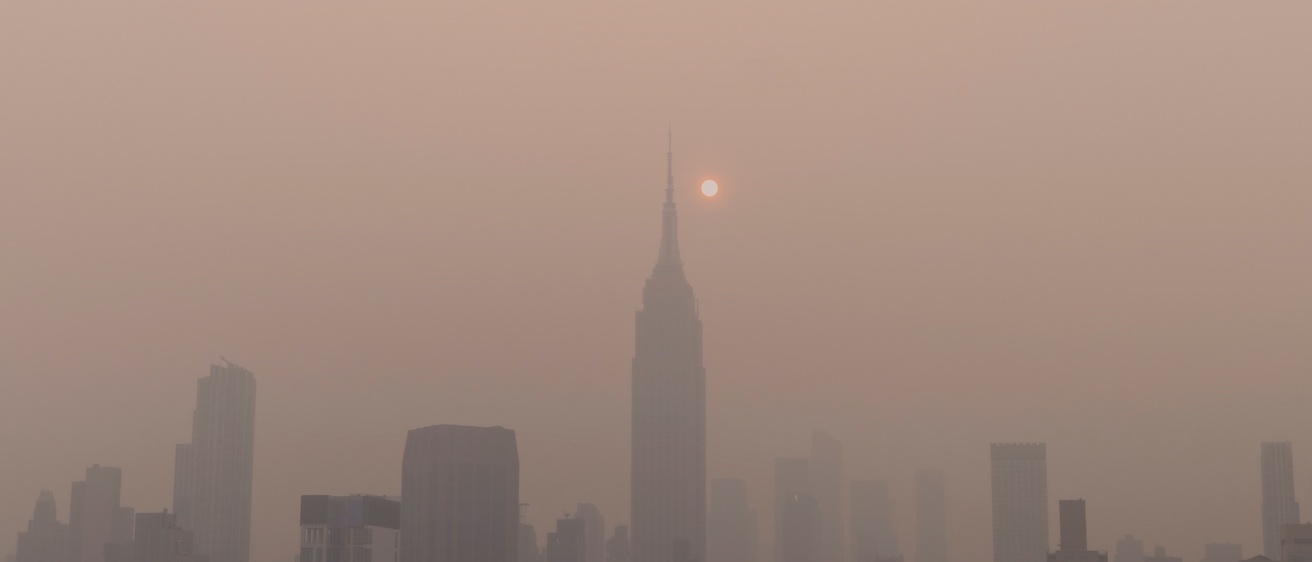The bright blue sky we’re accustomed to seeing over the Old Capitol dome recently has been disguised by a smoky haze from wildfires in Canada. The smoke has resulted in an air quality advisory issued for eastern Iowa and other parts of the state, disrupting some outdoor activities and putting people with certain health conditions on alert.

Charles Stanier, a professor of chemical and biochemical engineering in the College of Engineering who studies climate and the health effects of airborne contaminants, has been actively following and analyzing the air quality in our region and offers his expertise on the potential environmental effects of the wildfire smoke from western Ontario, Canada, that has made its way into Iowa.
Why is the air quality poor?
The air quality we’re experiencing is a combination of a weather pattern with a pattern of fire activity. The strong low pressure center we saw early this week induced a clockwise circulation drawing air from Canada into the Midwest. It was followed by a high-pressure system that is sitting over the Midwest now with low wind velocities. This is a common weather pattern.
Wildfire smoke from in western Ontario, Canada, and fires in Wisconsin resulted in hazy skies in Iowa and promoted the Iowa Department of Natural Resources to issue an air quality advisory throughout the entire state. The largest fires are in Ontario in pine forests.
Why is the smoke bad some days, but not others?
It takes a specific combination of fire activity and wind, and that combination can differ from day to day depending on the season. Winds are most calm in the early morning, and fire activity is most intense in late spring, summer, and fall.
Is it dangerous to be outside?
There are health risks to being outside when air quality is compromised, and some people are at a greater risk than others. The U.S. Environmental Protection Agency uses a six-level air quality scale that includes good, moderate, unhealthy for sensitive subgroups, unhealthy, very unhealthy, and hazardous. At unhealthy levels, scientific research shows an increased likelihood of health effects, particularly among sensitive groups, such as people with lung disease, heart disease, and children and older adults.
The effects fall disproportionately on those without air conditioning who rely on open windows, workers who have outdoor jobs, and those without flexibility or resources to make sure their kids have clean air to breathe.
What are the short-term and long-term effects of this weather event?
The short-term effects include aggravation of existing heart and lung conditions. Statistically, under conditions like this, we see an uptick in heart attacks and lung disease exacerbations. We will see a loss of forest resources and animal habitat in the burned areas, and experience disruptions from event cancellations, changes in outdoor activities such as camps, youth sports, and recreational facility use.
The long-term effects include a small population-wide increase in risk of heart disease, stroke, lung disease, and lung cancer. It may become more difficult to perform and enjoy outdoor activities, including camps, sports, outdoor festivals, outdoor restaurant seating, motorcycling, fishing, hunting, golf, bicycling, etc.
How can I find information about the daily air quality?
An interactive map of air quality is viewable at the AirNow website or the AirNow app. Many cities have an Air Quality Index (AQI) forecast that tells you what the local air quality will be later today or tomorrow, and a current AQI that tells you what the local air quality is now. The AirNow website also tells you whether the pollutant of concern is ozone or particle pollution.
